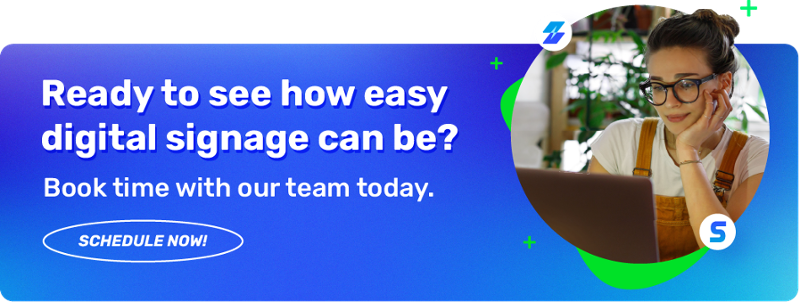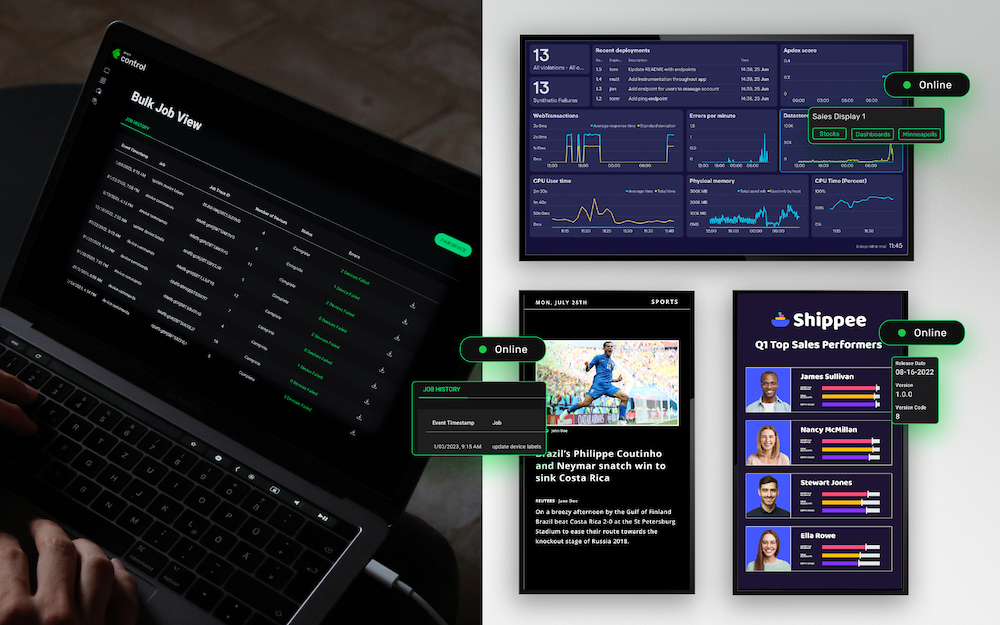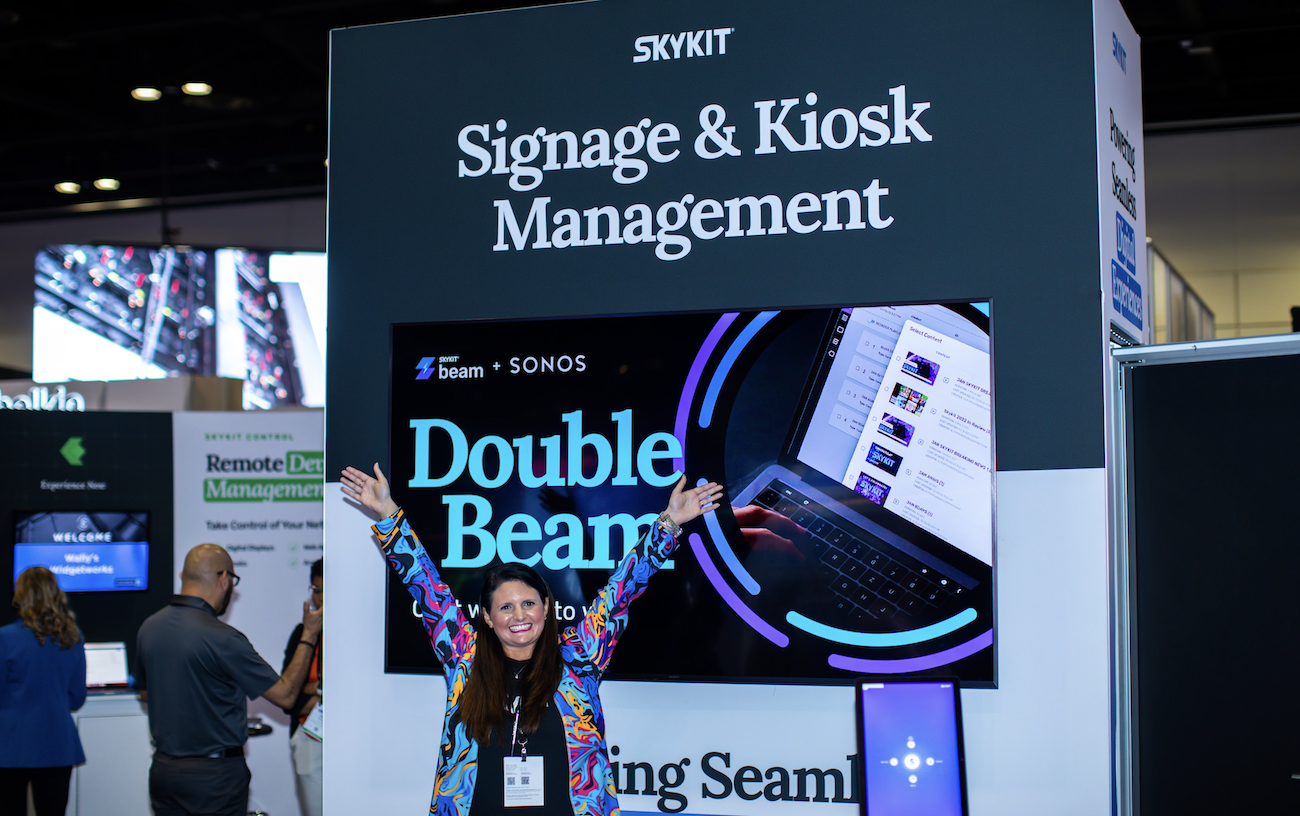Digital displays are always changing, so it’s crucial to understand the existing difference between LED and LCD screens. Where they were primarily used outdoors at large sporting events or other venues, LED screens are now popping up indoors – mostly thanks to a lowered price point and the flexibility of LED screen shapes.
As the popularity of LED screens grows, there’s still confusion regarding which kind of commercial-grade screen should be used: LED or LCD?
It’s a sticky subject, especially now that we are seeing more and more LED screens being used indoors. To help you better understand the difference, here’s a closer look at LED screens versus LCD screens.
Overview of LED
First, let’s talk about LED screens.
When To Use LED Screens
LED screens can range in size anywhere from 10 inches up to 95 inches. This type of display uses light emitting diodes to visualize images.
In terms of brightness, an LED screen ranges from 300 nits to 700 nits for low to medium light conditions, and 2500 nits for higher light conditions or outdoor applications.
Wait, nit? What’s a nit?
In a word, a nit is a unit of visible-light intensity. The more nits you have on your screen, the brighter the screen.
“When factoring in digital signage sizes, the implied viewing distance and the ability of the eye to discern the pixels and notice pixelation, a viewing distance of 1.25 to 2 meters can be expected,” writes Gary Feather, CTO of NanoLumens. “The digital signage system objective is one that the user’s content resolution will match the perception of resolution of the viewer’s eye, which is based upon the fovea of the eye and the distance to the screen, to the created resolution of the LED display.”
Before you decide to use an LED screen, consider lighting.
LED screens are more visible outside when compared to LCD or projection. That’s why you need a good LED, one that will stand up against heat, moisture, and varying light conditions.
If your digital signage campaign requires seamless tiled LED displays, realize they have a pixel pitch from 1.0 millimeters to 1.25 millimeters, and are being favored over the traditional tiled LCD displays.
Best part? LEDs are energy efficient, consuming up to 90% less power than other lighting options. They last longer, too. That means less time replacing and more time enjoying.
Where to Use LED Screens
If your display campaign requires you to use a screen that isn’t traditionally flat, using LED is the way to go.
As we said above, LED screens are most often used outdoors. If you’ve ever been to Times Square in New York, you’ve likely seen the rounded NASDAQ sign as you moved in and out of the heavily populated area. The iconic LED sign can’t be missed because it’s over seven stories tall.
The NASDAQ sign is the same digital sign that receives worldwide media attention on New Year’s Eve because it’s the sign that offers the big ball drop. It’s capable of displaying full motion video, live events, and social media feeds.
Because LED is flexible, it can adhere to any screen ratio or size, flexing around pillars or other unusual shapes. Having said that, if your signs are rounded or very large, LED would be the route you would want to take.
If you have screens that need to be up and running at a moment’s notice, LED signs light up very quickly. They are ideal for use in applications that are subject to frequent on/off cycling, too.
You can find LED screens indoors at large shopping malls or airports. A prime example can be found at the Dubai Airport in the United Arab Emirates. Dubbed the busiest airport in the world, the massive campus has chosen to adopt green technology to illuminate their new wayfinding LED signage.
Thousands of signs have been installed in Terminal 3 alone, the exclusive Emirates terminal. By the time the project is completed, the LED wayfinding signs will be installed in every terminal throughout the airport.
That’s a lot of light-emitting diodes, eh?
Overview of LCD
Now, let’s take a look at LCD screens. What is an LCD screen, and when should you opt for one?
When to Use LCD Screens
An LCD screen is a Liquid Crystal Display. This technology is typically used in laptops and tablets but can also be found on a larger scale with various indoor commercial-grade displays.
If you have viewers who are going to be up close and personal with your signage, an LCD screen is the better option. This is because the resolution is so high.
An LCD flat panel comes in 1080P and 4K UHD resolutions. Basically, the higher the resolution, the more pixels per inch covers the screen. The more pixels per inch, the clearer the image.
If your patrons are going to be viewing the screen from a distance, then you’ll need to display larger images. When viewing a typical LCD screen, experts like to adhere to what is known as the 4/6/8 rule.
The 4/6/8 rule basically says that there are three viewing criteria where images are to be viewed at a maximum:
- Critical decision making: 4X height
- Basic decision making: 6X height
- Passive viewing: 8X height
LCD screens are good for those that need a lightweight solution. For the most part, they are energy efficient, bringing about long-term cost savings. Because of lower power consumption, users can save money in the long run.
Think of DVD players, clocks and calculators. These are all pieces of technology that use LCD screens. We’re talking about LCD on a much larger scale, but it’s important to understand how much the screens have grown when deciding which type of screen you need for your digital display.
LCDs are better seen in brighter environments because of their anti-glare technology. The colors on an LCD screen look more realistic as well, which is why the food service industry goes with this screen for promotions and anything that shows images of food.
Bear in mind the placement of your LCD screen. Lighting matters. The protective glass layer on the LCD screen is quite reflective and can create a mirror effect. This can be an issue in certain lighting conditions, making the content hard to read.
Finally, some commercial grade LCD screens are as thin as an iPhone, making their sleek and savvy style attractive. Called the Art Slim series, the displays have a thickness of 7.5mm (1/4 inch), making them 75% thinner than a standard LCD screen.
The bottom line here is that while some in the digital signage industry believe LCD screens are on the way “out,” others recognize that they are easy to transport, easy on the wallet, and offer brilliant color, style and imagery, making them still very much “in.”
Where to Use LCD Screens
Because LED seems to be the favored technology in digital signage, LCD screens can be found mostly in and around smaller scale projects. They are ideal in small office settings for trainings or in retail stores to entice customers to buy sale items. LCDs can also be found in the convenience store industry.
San Francisco-based f’real released a milkshake machine that does more than just pour milkshakes. The new digital displays pour the shakes in a minute, which is cool, but the really cool thing is that when shakes aren’t being made, the machines plays a video on a 22-inch screen to attract customers.
I don’t know about you, but I don’t think I’ve ever seen a milkshake machine with a movie before. I think that would be neat to stand back and watch, just to marvel at the unique roads technology has carved in the land of digital signage.
LCDs also make an appearance in the retail industry, touchscreen style. We see them as kiosks in fast casuals and as tabletop tablets in restaurants.
At Applebee’s, tabletop devices assist servers by encouraging patrons to order appetizers or a second round of drinks via the device. If that’s not enough, you can pay your bill at the same LCD screen you ordered your drinks from. Really, no server is required. Just a credit card and the touch of your finger.
Pick a Winner: LED or LCD Screens?
With the growth of LED and the new technological advancements the displays now provide, LED solutions are both attractive and affordable.
At the same time, LCD has a much sharper image, so most companies use this to display their high-quality images and videos.
Both options are available at price points that offer savings in the long run. Having said that, going with the most affordable option may not always be the best idea.
Lighting is a huge factor, and you must take this into consideration whether you’re installing indoors or outdoors. Does the weather in your area play a role? If so, elements like placement or different LCD options need to be evaluated.
For more details and comparisons, check out our post on when it makes sense to use LED screens for digital signage.
So now that we’re clear, are you an LCD or an LED fan? Which option works best for your industry?




